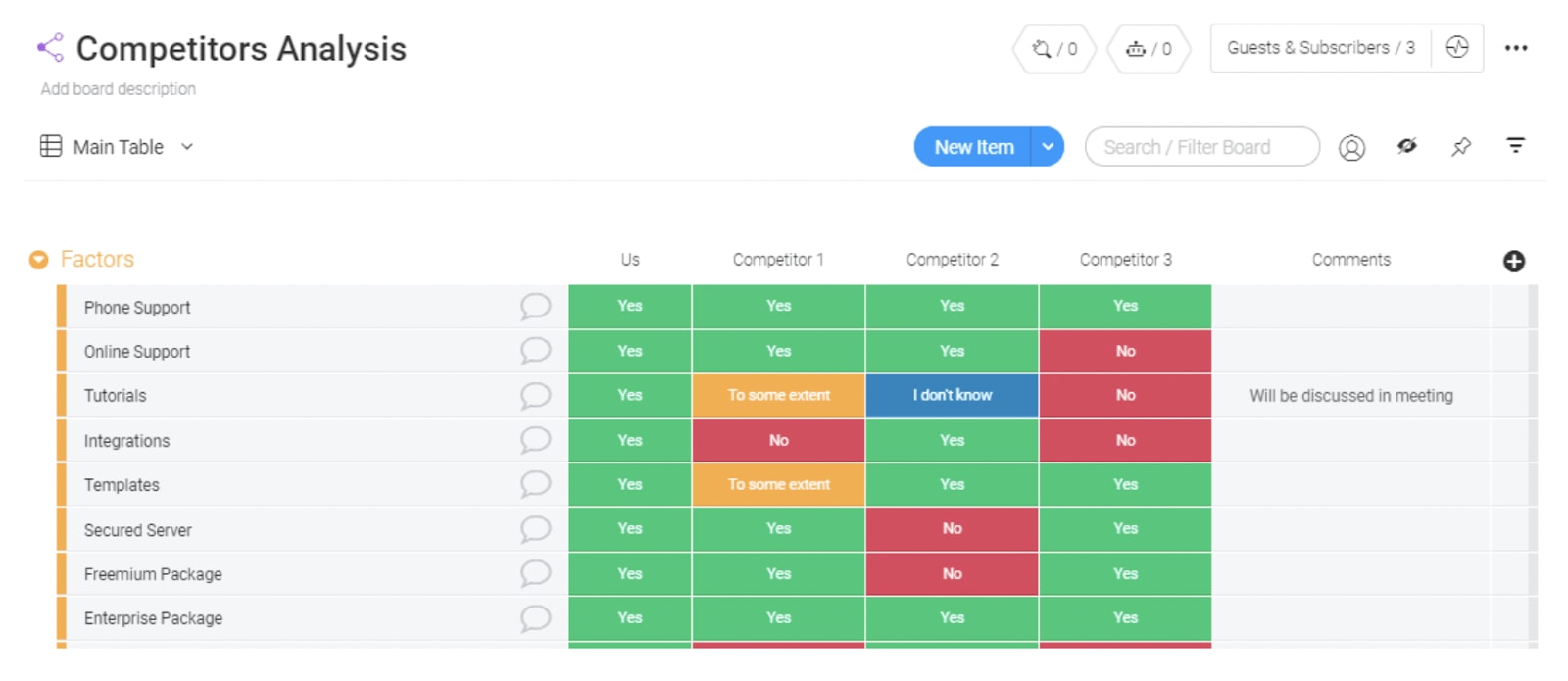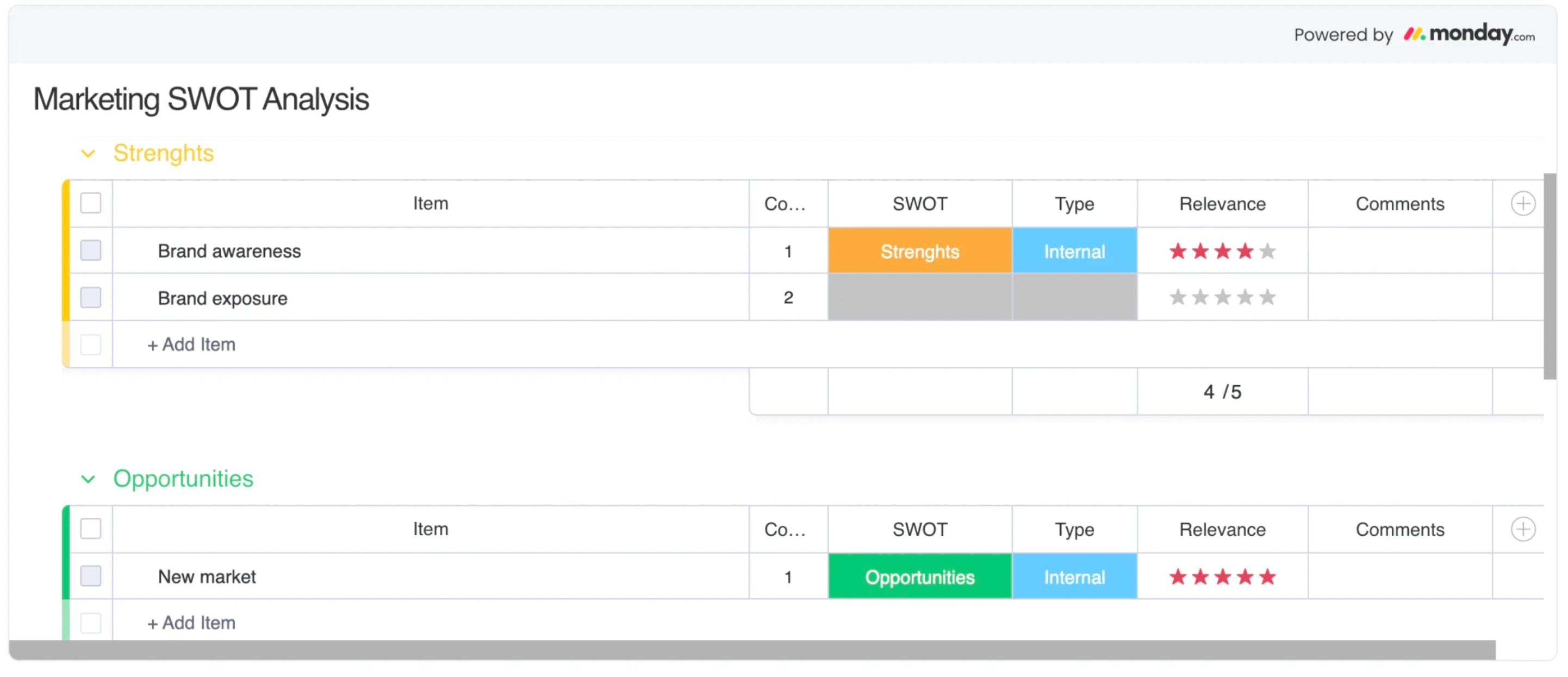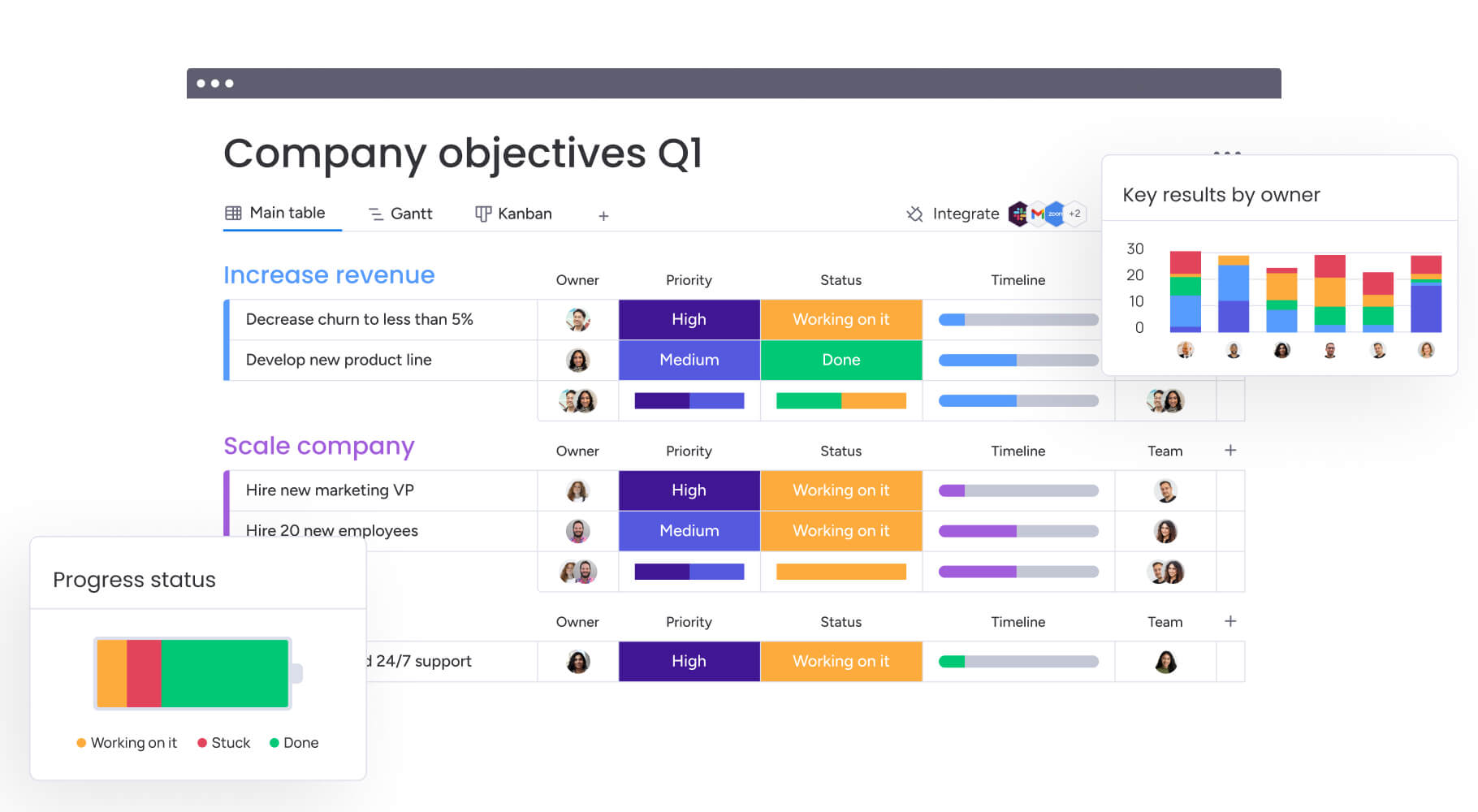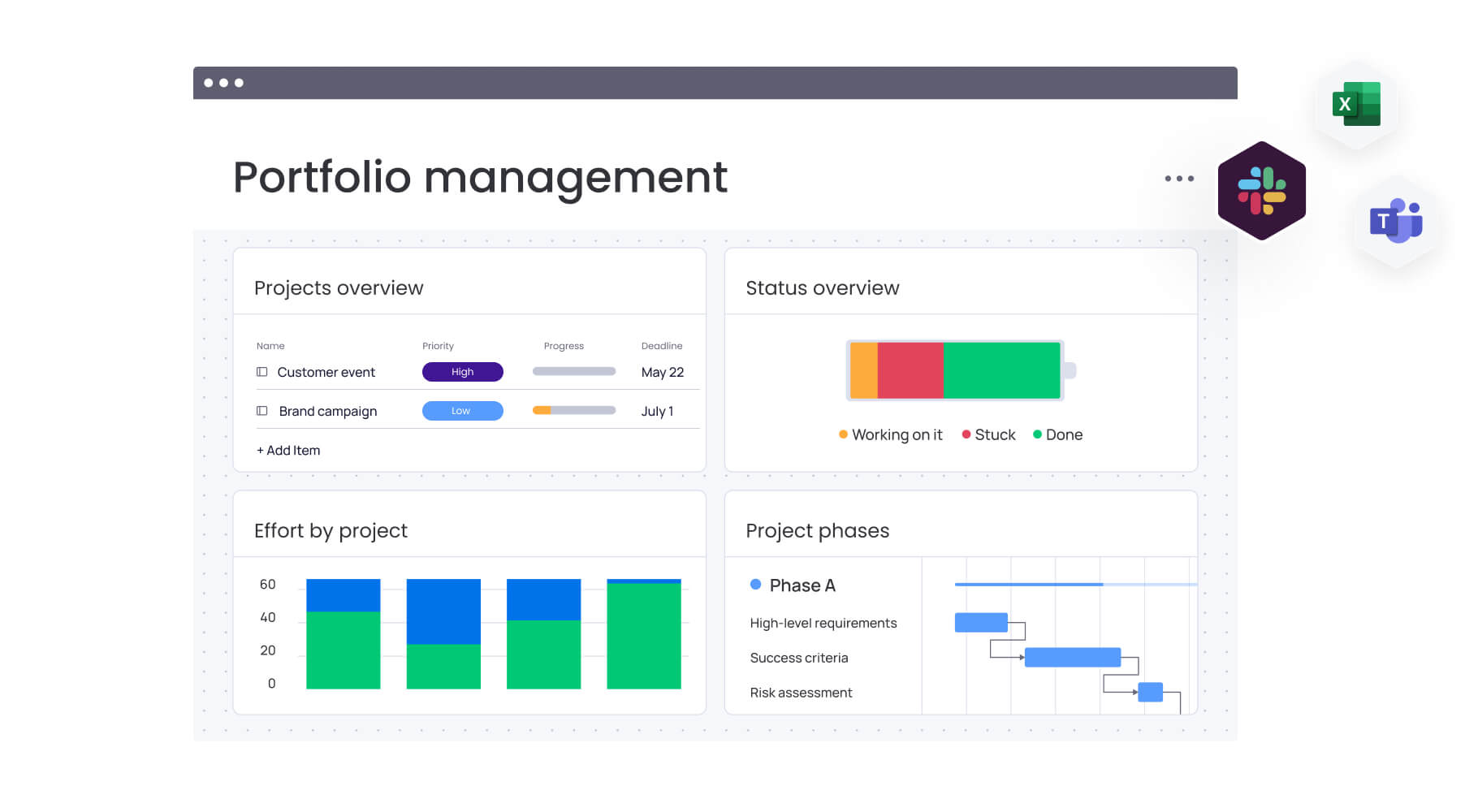You may have a great idea, a fantastic product, or offer a stellar service, but chances are so do your competitors. To stand out in a competitive landscape, it’s essential to gain a good grasp of industry trends and exactly what your major competitors are offering.
Conducting a competitive analysis is an important step for any business owner who wants to corner customers’ attention when it’s being divided among different brands. Gaining deep insights and understanding where your competitor’s strengths and weaknesses lie can only help you refine your offering and position your business as the superior choice.
In this post, we’ll look at what a competitive analysis is for and what its benefits are. We’ll also dive into how you can conduct your own and why using a platform like monday work management can help you make sure your competitive analysis leads you to success.
Get startedWhat is competitive analysis?
Competitive analysis is the strategic process of identifying direct and indirect competitors and comparing them with your own business or brand for the purpose of understanding strengths and weaknesses.
Competitor analysis involves gathering data on different aspects of your competitors, like products, services, marketing strategies, customer base, pricing, and market position.
In a competitive analysis, companies can better break down what sets them apart from other businesses in the same field or those offering similar products and services. This can help companies refine their strategies and gain a competitive advantage.
Why should you conduct a competitive analysis?
Being aware of who your competitors are and what they’re doing is just the tip of the iceberg. Conducting a competitive analysis comes with several other benefits that can help you position your product or services in a way that helps you attract more interest and grow your brand. Running a competitive analysis can help your business by:
- Identifying your key competitor’s strengths so you can find opportunities you may have overlooked for your business
- Taking advantage of competitor weaknesses by shining in areas where they lack
- Finding target market segments that are being underserved by your competitors
- Determining what specifically makes your business different and focusing strategies to highlight those aspects
- Developing or strengthening your Unique Value Proposition
- Staying afloat of the market landscape and changes so you can stay ahead of the competition
Pro tip: wanna streamline your analysis? Use our competitor analysis template.

What should be included in a competitive analysis?
Your competitive analysis can be as detailed as you want it to be and include as many or as few factors as you want to research. Ideally, you’ve set yourself a goal of what you want to compare and you’ll look at factors from your competitors that will align with your comparison objective. Still, there are four core aspects you want to make sure you cover in each and every competitor analysis, such as:
- Company overview: First define your competitor and gather data such as the size of the company, funding, background, and ideal customers
- Product research: You should conduct a competitive product analysis by looking at the products or services your competitor offers, including different features, pricing strategies, support options, and what stands out most
- Audience: You should be looking at who your competitor’s target audience is, including demographics, behaviors, pain points, and their sentiment toward your competitor
- Marketing tactics: Examine your competitor’s various marketing channels and strategies including campaigns, search engine optimization (SEO), social media posts, email marketing, content strategy, partners, PR, and their website
How to conduct a competitive analysis in 6 steps
Following the steps below, you can conduct your own analysis and create a competitive analysis report to use to gain insights for your business. These steps can help you analyze one or several competitors at once. Let’s jump right in.
1. Identify competitors
First things first, you need to determine who your competitors are. To build a comprehensive list of competitors, you’ll want to break this step down into two types of competitors: direct competitors and indirect ones.
Direct competitors are businesses that offer similar products or services, so the company will more closely resemble your own. For example, if Netflix was doing a competitor analysis, Hulu or Disney+ would be considered a direct competitor.
An indirect competitor, on the other hand, is a company that has different offerings but meets the same customer needs. So for Netflix, YouTube or TikTok could be indirect competitors since while they both offer video content, the platforms offer different focuses but could still divert attention away from Netflix’s services.
To identify either type of competitor, start by scouring search engines like Google or Amazon for products similar to your own, do research into each competitor’s market share and audience, and keep tabs on them regularly.
2. Determine the competition’s market positions
To properly analyze your competitors, you need to know where each one stands in the market and what your brand’s position is as well. To do this, you’ll need to map your competitor’s market positions.
Start by ranking your competitors based on factors like audience size, customer satisfaction, and product pricing. Then, you can sort low-ranking and high-ranking competitors to determine the leaders you should focus on and to better understand how to compete with them.
3. Research core competitor factors
Based on the four factors we discussed above, do a deep dive into each competitor’s offerings and strategies. The elements you look at can look different depending on your goal for your competitive analysis, but here are some examples of what to examine for some of the most common factors.
| Product offering | Marketing strategies | Pricing models | Customer experience |
|---|---|---|---|
| Product range & features | Website design, online presence, and SEO strategies | Rates and pricing structure | Customer support options |
| Product quality and performance | Content marketing | Discount and promotions | Shipping and delivery |
| Customer reviews and ratings | Social media strategy, presence, and engagement | Value for money | Loyalty and referral programs |
| Unique selling proposition (USP) | Brand messaging and market positioning | Add-ons and upsells | Customer service and product reviews |
| Innovation and product development | Advertising channels | Perks like free trials | Customer retention |
4. Understand what tech your competitors are using
Aside from doing deep research into your competitor’s products, branding, and user experience, you should also take a look at the technology they use. This is important because often the technology a company uses can enable them to accomplish things like quick deliveries, excellent customer service, or better customer loyalty.
Whether it’s an e-commerce solution, customer success platform, plugins, AI tools, or a work management platform, understanding the systems your competitors use can help you unlock new capabilities and open the door to fresh possibilities. A good way to find out what technologies competitor websites use is to look at their websites with BuiltWith.
Get started5. Perform a SWOT analysis of your competition

Once you near the end of your competitive analysis, you’ll want to perform what’s called a SWOT analysis. A SWOT analysis is a breakdown of a competitor’s strengths, weaknesses, opportunities, and threats. You can treat this as a last step after you’ve already analyzed your competitor and gathered research. In a SWOT analysis, you’ll want to be able to answer questions like:
- Where do my competitor’s strengths lie?
- What is their weakest process?
- Is there something specific that gives them an advantage over your brand?
- How does this competitor act as a threat to your brand?
- What could this competitor improve on?
- What market opportunities is this competitor not addressing?
- What can your company do better than your competitor?
By having a clearer picture of a competitor’s strengths and weaknesses, you’ll better understand where they act as a threat and what opportunities you can take advantage of to position yourself ahead of your competition. You can use a SWOT analysis template to easier organize your competitor research.
6. Implement strategies and tools to stay on top of the competition
After collecting all the research and performing a SWOT analysis, you’re now in the stage where you’re starting to ideate and implement new competitive strategies. You should also, at this stage, have a clear idea of the market share for each of your competitors as well as your own company.
Based on your research, you can begin to develop new strategies, whether that’s finding a different pricing structure, improving the customer experience, or organizing your work and tasks with new technologies in order to stay competitive.
Expert tips to strategizing your competitive analysis
We caught up with industry leaders to get some real-word examples of how they perform competitive analysis.

Ben continues – “If it turns out that 90% of your competitor’s sales are done via existing relationships and channel partners that take a long time to build, rather than easier-to-replicate marketing tactics like SEO and social media, your growth and launch may be a lot slower than expected. That being said – your competitors are only a signal.
You never know what’s happening internally vs what they present to the world, having been on the inside of sinking ships that look like they’re doing super well – I can assure you it’s better keep focused on your own data. The SEO world is a classic example of this, we see sites we all want to copy and then…they get destroyed in an algorithm update 6 months later.”
Ben Goodey, Founder | Spicy Margarita

Jonathan continues – “Imagine this: you and your competitors are selling nearly identical products, yet their websites are consistently pulling in more traffic. When you dive into an SEO tool to investigate, the reason becomes clear – they’ve created additional category or landing pages strategically designed to attract search traffic.
For instance, while you might have one generic page for “running shoes,” they could have multiple – highly targeted pages like “trail running shoes,” “lightweight running shoes,” or even “running shoes for beginners.” These additional pages give them more opportunities to rank for specific keywords, meet customer needs, and ultimately drive more traffic to their site, without the need to inflate the number of their SKUs, which, as we all learnt from the Zappos story, is a nightmare.
To close this gap, start by creating a matrix of competitor landing or collection pages and compare it to your own site’s structure. Look for categories or subcategories your competitors are capitalizing on but you’ve overlooked. By identifying and building out these new opportunities for products or services you already offer, you can position your website to perform more competitively in search rankings – and better serve your audience’s needs.”
Jonathan Kiekbusch, Managing Director | SwishDM

Radek continues – “How a product is positioned, communicated, and sold can make just as much of an impact as what’s inside the package. If you only analyze what a competitor offers rather than how they market it, you’ll miss a lot of key insights. Look at their messaging, the channels they use, and the way they attract customers. A strong product isn’t always enough—how it’s presented and sold often makes the difference.”
Radek Kaczynski, CEO | Bouncer
Manage your competitive analysis research and results with monday work management
There’s a lot that goes into competitive analyses. There’s research, links, and findings you want to keep note of to help strengthen your brand. Once you’re finished with your analysis, you also want to organize the results and turn them into a tangible action plan. Accomplishing all of this without a unified platform can be daunting, so when performing a competitive analysis, it’s best to find a solution like monday work management.
With monday work management, you can access hundreds of templates that make it easy to track and sort all your research in one place. Let’s look at a few more monday work management features that can help you make your next competitive analysis more successful.
Customizable templates and boards

With monday work management, you can get started instantly with a pre-made template and then customize it to your liking to fit your unique competitive analysis. Tailor your templates with custom columns for priorities, assigning responsibilities, timelines, ranking relevance, categorizing competitors, and more.
Data-driven competitive insights and reports

monday work management offers valuable insights and analytics to help you understand more from your competitive analysis. With visual dashboards to keep a quick overview of the status of your analysis as well as features to automate a customizable competitor analysis report, you can narrow down your results into actionable insights.
Collaboration tools

Get your team all on board the analysis processes with monday work management’s robust collaboration tools. Add comments, files, documents, and links all in one place so nothing gets lost, get real-time updates on changes so your team can always be aligned, and assign tasks with due dates so everyone knows their role in the analysis.
Get startedMake sure your next competitive analysis counts
When done well, the impact of a competitive analysis can have far-reaching effects that help you align your company with market expectations and optimize your business strategy. With a platform like monday work management in your toolbox, you’ll be set up to succeed by storing, planning, and organizing all your analysis data and tasks in one comprehensive environment. Rather than spending time and resources managing your competitive analysis data, monday work management allows you to focus on analyzing the data you find and turning it into winning business growth strategies.
FAQs
Is a SWOT analysis the same as a competitive analysis?
A SWOT analysis and a competitive analysis may sound similar but they aren’t the same thing. SWOT is focused more on arriving at informed decisions based on strengths and weaknesses, while a competitive analysis is more general and involves evaluations of a competitor’s market position.
What are the three C's in competitive analysis?
The three C’s in competitive analysis are Company, Customers, and Competitors. These represent a focus on understanding a business itself, its audience, and its rivals and can be used to create more target marketing strategies and differentiate your brand from others.
What is a competitive analysis grid?
A competitive analysis grid is a chart that compares competitors across key factors like pricing, product features, market position, and others, for the purpose of visually identifying strengths and weaknesses.
 Get started
Get started 

